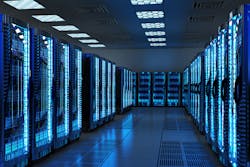Life-Cycle-Cost Analysis for Data-Center Thermal Equipment
Performing life-cycle-cost analysis (LCCA) for critical-infrastructure equipment means taking an objective look at thermal equipment, as upgrading or replacing thermal equipment is a cost-effective approach to boosting efficiency and reliability and optimizing data-center performance.
Key considerations for determining whether to upgrade or replace thermal equipment include:
- How is the equipment performing in terms of efficiency and uptime?
- How much does the equipment cost to maintain?
- How much would the equipment cost to replace?
- How long is the return on investment?
Data-center operators face a changing landscape. Increasingly, new data-center capacity is being provided through consolidation of facilities using colocation or cloud hosting. Colocation is an attractive choice for companies operating enterprise data centers—they are ahead of the curve in offering a reliable infrastructure that allows companies to reduce operating costs. Colocation providers have been quick to adopt new, more efficient technology. Rapid scalability and lower costs are two key reasons enterprise-data-center managers migrate applications to colocation.
Companies consolidating data centers usually are seeking to operate more efficiently and reliably and lower risk through greater infrastructure protection and security. Today’s vital thermal-management systems are equipped with variable-speed fans and variable-capacity compressors. They reduce energy consumption, may reduce water consumption by using refrigerant pumps for free cooling, and offer thermal-management controls for optimal efficiency and protection.
For sites with legacy equipment, the question remains whether to upgrade or replace. The answer lies primarily in the age and features of the equipment and how well it has been maintained and upgraded. For example, is the owner committed to working with qualified service technicians to ensure the continued viability of thermal equipment?
Let’s look at three different scenarios: a thermal system more than 15 years old, a thermal system less than 10 years old, and a thermal system less than 2 years old. These scenarios assume regular service by OEM-certified technicians (more on the importance of that later).
More Than 15 Years Old
It is nearly certain thermal systems this old do not have the factory-installed variable-speed technologies and intelligent controls of today’s systems. A company with tight budgets might believe it needs to make such systems last. Chances are, money is being spent on repairs and replacement parts, with more to be spent over time. The equipment likely is wasting energy. Should an upgrade be considered? Maybe.
It may be less expensive to replace such a system. The replacement of even a very-well-maintained older system may pay for itself in less than four years and recoup perhaps nearly half of the cost in the first year.
Yes, a capital investment must be made, but that investment also would deliver savings. Annual cooling costs would drop, while the new system could qualify for an energy rebate of perhaps 25 percent of equipment costs. Maintenance costs certainly would be reduced, and power-usage effectiveness would improve significantly. Continuous upgrading of such a system could provide a long life of efficient, reliable service.
If cost exceeds available capital, there is the option to lease. This approach spreads out cost and enables savings to start immediately.
Less Than 10 Years Old
Units less than 10 years old likely are operating reliably, but not as efficiently as they once did. Retrofits could save up to 30 percent on annual energy costs. Upgraded controls could help achieve more effective cooling across the data center, eliminating hot spots and optimizing energy use.
Variable-speed fan technologies can reduce fan speed by providing only enough airflow to meet room load. Reduced fan speed can cut fan energy use significantly compared with existing constant-speed fans. Variable-speed drives also provide per-unit savings.
Maintenance and repair costs certainly would drop. With new variable-speed fans and controls, a system could run at a higher return-air temperature, reducing the need to run all cooling units all of the time. Some units could go into standby mode for redundancy and reduction of system wear and tear.
Less Than 2 Years Old
For the last scenario, let’s assume equipment is new. The system has high reliability and redundancy and is performing at maximum energy efficiency because of unit-level monitoring and control. There is no need to replace or retrofit equipment.
An owner would want to keep such a system running at peak levels. Staying abreast of software and control updates would be key. Costs would vary as software changed, but optimization of the system would ensure the investment provided the desired reliability and efficiency.
A Word About Service
When performing LCCA, it is important to consider the level of service thermal equipment will receive. Knowing who and when to call can ensure system reliability and extend equipment life to the point such service pays for itself. “Bargain” service is no bargain when one considers proper maintenance is more than changing filters or making a nuisance issue go away only to have it return two or three weeks later.
Over time, system configurations can change, as can standards and service-life agreements. OEM-trained technicians, especially those who return for recertification training, provide value well beyond the cost of service. They are critical to a thermal-management system’s optimization in terms of efficiency and reliability.
As marketing manager, cooling services, for Vertiv, Mark Silnes develops new- and existing-service offerings related to thermal management. Previously, he held roles in application engineering and business development. He can be contacted at [email protected].
About the Author
MARK SILNES
Marketing Manager, Cooling Services
As marketing manager, cooling services, for Vertiv, Mark Silnes develops new- and existing-service offerings related to thermal management. Previously, he held roles in application engineering and business development. He can be contacted at [email protected].
